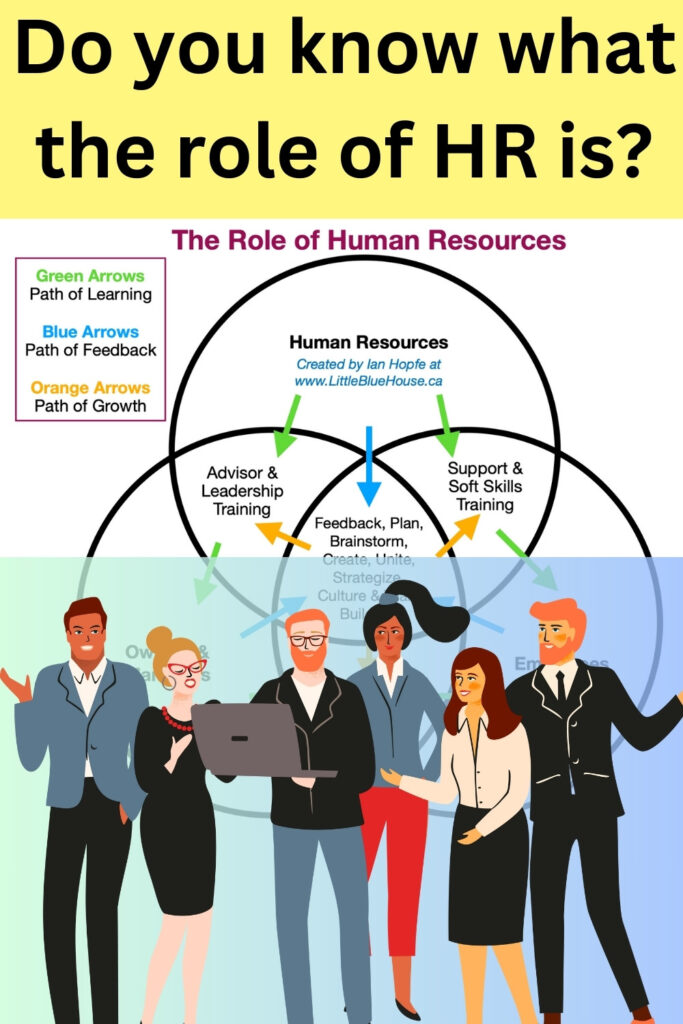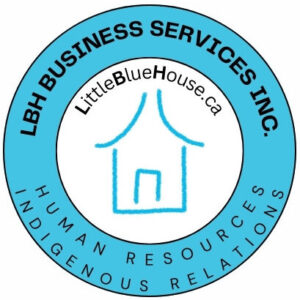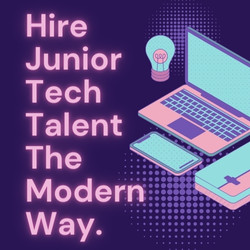This blog article conforms to our Editorial Policy and contains links to paid referral affiliates.
My clients are always asking me questions like: What is human resources? What is the role of human resources? Human Resource (HR) departments, professionals, consultants, and advisors may be a big mystery. So, in this blog post, we will improve your understanding of HR. In addition, we might dispel some misconceptions.
The human resource department or advisor(s) have three main roles in an organization that encompass all HR functions. First, the role of human resources is to advise and give leadership training to owners, managers, and supervisors. The second is to support and give soft skills training to employees. The third is to give feedback and help with the strategic development of the organization.
For the rest of this blog, we will take a deep dive into the topic of what human resources are, what types of human resources there are, and how human resources help an organization.
What Do HR Consultants Do?
Naturally, human resource functions are what HR Consultants do. However, these can be varied. Therefore, it’s sometimes easier to examine this from external and internal points of view.
The Role of External HR Consultants
An external HR Consultant will normally be called in to do high-level work. Primarily to help the owner or manager of an organization. So, they’re a brainstorming resource to help develop strategy, tactics, policy, and training.
Naturally, smaller organizations that can’t afford a full-time HR department can use HR Consultants. Similarly, large organizations going through changes or reorganizations may call in more help.
The Role of Internal or Corporate HR Advisors
Internal HR Advisors do the daily or operational tasks of the organization or corporation. For instance, the tasks could be related to recruitment, performance, policy, benefits, training, data tracking, and advising.
Much of this is administrative-related work. However, with a high level of internal customer service interactions with managers, supervisors, and employees. In addition, recruitment work has a high level of external interaction.
To learn what your top HR Manager’s role is, read this article, “The Role of The HR Manager“.
How Much Should You Spend on HR?
I have a lot of owners and managers asking me what Human Resources support they need and what they should be spending. I wrote a whole article on the number of employees and how much you should on HR. Click here now to read the article and see that chart with all the data.
What HR Consultants Do Not Do?
The major misconception is that HR Consultants and Advisors are supervisors or leaders of organizations. HR only supervises and leads their own HR department. HR is not the “watchdog” of the organization looking for wrongdoers. This gives HR a bad rap because HR’s primary goal is to help an organization with advising and training.
Human Resources Advises Leaders
HR advises supervisors and managers to be better leaders. Therefore, discipline, performance, and terminations should not be turned over to the HR department. HR does not see how the employees work each day. To that end, supervisors and managers do these leader work tasks but ask HR for help if needed.
Human Resources Track and Analyze
Completed leader work done by the supervisors and managers, is given to HR. Then, HR tracks and saves that information and data; updating any HRIS. Ultimately, HR analyzes this information and data regularly. Most importantly, this data will be used to make strategic and tactical recommendations to management or train employees.
Differences in the Role of Human Resources
Depending on where HR is practiced there may be some differences, naturally. So, small organizations and large organizations have different needs. For instance, the larger the organization is the more specialized and narrow will an HR advisor’s role be. In addition, there are even differences in legislation from province to province and country to country .
.
Diagram of the Role of Human Resources
Moving on, here is a diagram or infographic of the role of HR in an organization. In addition, below it, we have explained more about the flow and paths for your understanding.
The Path of Learning
The Path of Learning is how an organization keeps all employees and management up to date. Therefore, these could be current industry skills and previous corporate interactions, pivots, and paradigm shifts. Above all, this is the start of the role of human resources in an organization.
Advising Owners and Managers
The HR department will be the advisor of the owners and managers. Owners and managers are experts in the business of the organization. Although, they may not be experts in people, corporate culture, work environment, and the laws of the land.
Read my article “Managers Need HR Support” to better understand the skills and experience needed to be a good manager.
This HR advice is confidential. Supervisors should be given it before any action by the manager is taken. Unfortunately, advice is often sought when issues become a crisis after the wrong action was taken by the manager.
Therefore, HR departments are considered separate from the rest of the employees.
In some cases, owners or managers become friends with employees or invite friends to work for them. Being friends with someone you supervise can be difficult but check out my article “My Employee is My Friend” for some guidance.
Leadership Training for Owners and Managers
Leadership is a different skill set from doing everyday tasks and supervising employees. For instance, leaders work to model the way, inspire a shared vision, challenge the process, enable others to act, and encourage the heart. I encourage you to read “The Leadership Challenge” by James M. Kouzes and Barry Z. Posner (Paid Link) on Amazon.
(Paid Link) on Amazon.
Leaders must understand the needs of their employees. A leader recognizes that employees are people with basic needs. If you can support your employees well enough, your employees will be happy, allowing your organization to prosper.
Read my blog article “Hierarchy of Employee Needs.”
Support for Employees
HR departments have a unique dual role. In other words, they must support both management and employees with privacy and respect. Employees have issues that only HR can help them with. For Instance, when it relates to a supervisor or manager. However, there is still a stigma that HR only works for management. In conclusion, organizations are just starting to realize the advantage of this dual role.
HR may also advise employees on how to advance their careers or even change careers. Read my article “Practical Steps for Changing Careers” to learn more.
Soft Skill Training for Employees
The HR department creates, conducts, or outsources training courses for employees. HR training should centre on soft skills like leadership, sales, networking, customer services, and conflict management. To this end, HR training should be geared toward the advancement of employees’ careers.
To learn more read my article “Training Responsibilities of the HR Department.”
Leadership for Employees
The true leaders of an organization should be the owners, managers, and supervisors. Therefore, leadership skills learned from HR should be implemented and passed down to employees. For instance, a good manager has good leadership skills. Employees should be excited to get constructive criticism from a leader. Similarly, employees should be willing to work hard for a leader.
A good leader needs to learn more about the needs of employees read our article “Hierarchy of Employee Needs“.
Hard Skills Training for Employees
Due to everyday roles, you need hard skills. So, a cashier needs to learn how to use the cash register. Similarly, the accountant needs to learn how to use accounting software. In addition, an administrative assistant needs to know how to use the phone system, photocopier, and wordprocessing program. Your supervisor or manager should initially teach you all these skills.
Check out our article “Hard Skills Training Responsibilities of Supervisors” to learn more.
Path of Feedback
Have you ever been in a meeting when the boss asks for feedback? Then no one speaks. This is bad and means there are all kinds of issues with the organization’s work environment and culture.
This is the opportunity for HR, managers, and employees to help create a good work environment. Click here to read my article called “What Is a Good Work Environment?” to help you.
Feedback from Human Resources
As stated above, HR has a unique dual role of helping management and employees. This allows for the ability to understand both sides of an issue. Therefore, HR may give feedback that can be a compromise or synergy of both sides.
I have some great experience as an HR Consultant. To learn about my experience and get feedback, read my article “Top Employee Issues.”
Feedback from Employees
The employees are normally the largest group in an organization. In other words, don’t let all that brainpower go to waste. So, use those brains to discover creative ideas and develop them.
Employees are also the experts in day-to-day tasks and operations. Naturally, they may have simple insights that may lead to savings. After that, they may even revolutionize the organization.
To learn more about getting employee feedback, start reading my Hired Brain series of articles, “Hired Brains: Benefits of Maximizing Your Employee’s Ideas.“
Feedback from Owners and Managers
Owners and managers have insight into the bigger picture and goals of the organization. Therefore, sharing these pictures and goals with employees will help keep brainstorming on track or allow them to evolve as needed.
Getting feedback from owners and managers can be challenging. Read the article “Get Feedback from Owners and Managers” for helpful tips!
Path of Growth
Above all, an organization should collect feedback and brainstorm as a team. So this will help to define future needs, goals, and opportunities. After that, ensure these are actioned and pushed out to the team. Moreover, this is how an organization experiments and grows beyond the current standards. Most importantly, this allows an organization to stay viable in the future.
Improve Advising & Leadership Training for Owners and Managers
HR needs to know the direction and goals of the organization. In addition, they need to know how employees react. After that, HR can develop the proper help for owners and managers.
As society changes, human interactions also change. However, these changes are also being better understood. So, today’s leaders always need to grow. For instance, HR can help develop the proper training after understanding the needs of employees, managers, and owners.
Read this article to learn “What Your First HR Advisor Should Do?” to help your organization.
Improve Support & Soft Skills Training for Employees
Properly addressing employee work issues is vital for creating trust and loyalty. Therefore, HR can be a big part of this process. As a result, employees need to learn to trust HR. Similarly, employees need to see that things can change and improve. Above all, HR needs to find out what skills employees really need to advance their careers.
Read this article to start learning the “Top Ways HR Can Support Employees“.
Improve Leadership & Hard Skills Training for Employees
Leaders are the driving force for any organization. They know the roles and they have learned to manage people. Therefore, your best accountant may not be your best manager. For instance, they may not have people or management skills. Above all, find your future leaders and teach them!
Read this article to start learning how to “Train Your Leaders to be Trainers“.
Conclusion to The Role of Human Resources
This whole process of the role of human resources can be summed up in four steps. Although, we like the fancy diagram above better!
Four Steps of the Role of the Human Resources Process
- Work, train, and lead by current standards
- Give and get feedback from all levels
- Brainstorm and develop new standards as a team
- Work, train, and lead by the new standards…then repeat!
The Role of Human Resources is Vital
In other words, this may be a slow process. Similarly, your organization may only work on one area at a time. Above all, it’s important to try to improve the organization. In conclusion, change and experimentation allow an organization to adapt to the future market, industry, or society.
For human resources support in Canada, click here to book a free HR needs assessment now. If you’re on a budget, consider joining my Patreon to ask unlimited HR questions. If you need HR advice sooner, book a consultation via Fiverr here.
HR questions. If you need HR advice sooner, book a consultation via Fiverr here.
Pin to Pinterest!





